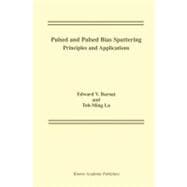
| PREFACE | ix | ||||
| ACKNOWLEDGMENTS | xi | ||||
| Chapter 1 INTRODUCTION | 1 | (10) | |||
|
1 | (5) | |||
|
6 | (1) | |||
|
7 | (2) | |||
|
9 | (2) | |||
| Chapter 2 BASIC PLASMA PHENOMENON | 11 | (18) | |||
|
11 | (2) | |||
|
13 | (9) | |||
|
22 | (4) | |||
|
26 | (3) | |||
| Chapter 3 PLASMA SOURCES USED FOR SPUTTER DEPOSITION | 29 | (16) | |||
|
29 | (9) | |||
|
38 | (4) | |||
|
42 | (3) | |||
| Chapter 4 RESPONSE OF A PLASMA TO AN APPLIED BIAS | 45 | (20) | |||
|
46 | (3) | |||
|
49 | (5) | |||
|
54 | (3) | |||
|
57 | (5) | |||
|
62 | (3) | |||
| Chapter 5 SINUSOIDAL WAVEFORM | 65 | (10) | |||
|
65 | (4) | |||
|
69 | (3) | |||
|
72 | (3) | |||
| Chapter 6 PULSED WAVEFORM | 75 | (34) | |||
|
76 | (1) | |||
|
76 | (13) | |||
|
89 | (6) | |||
|
95 | (9) | |||
|
104 | (2) | |||
|
106 | (3) | |||
| Chapter 7 APPLICATION OF A PULSED WAVEFORM TO A TARGET: PULSED REACTIVE SPUTTERING | 109 | (20) | |||
|
110 | (2) | |||
|
112 | (9) | |||
|
121 | (6) | |||
|
127 | (2) | |||
| Chapter 8 APPLICATION OF A PULSED WAVEFORM TO A SUBSTRATE: PULSED BIAS SPUTTERING | 129 | (16) | |||
|
129 | (1) | |||
|
130 | (3) | |||
|
133 | (5) | |||
|
138 | (5) | |||
|
143 | (2) | |||
| Chapter 9 CONCLUSIONS AND FUTURE DIRECTIONS | 145 | (4) | |||
|
145 | (1) | |||
|
146 | (3) | |||
| REFERENCES | 149 | (8) | |||
| INDEX | 157 |
The New copy of this book will include any supplemental materials advertised. Please check the title of the book to determine if it should include any access cards, study guides, lab manuals, CDs, etc.
The Used, Rental and eBook copies of this book are not guaranteed to include any supplemental materials. Typically, only the book itself is included. This is true even if the title states it includes any access cards, study guides, lab manuals, CDs, etc.